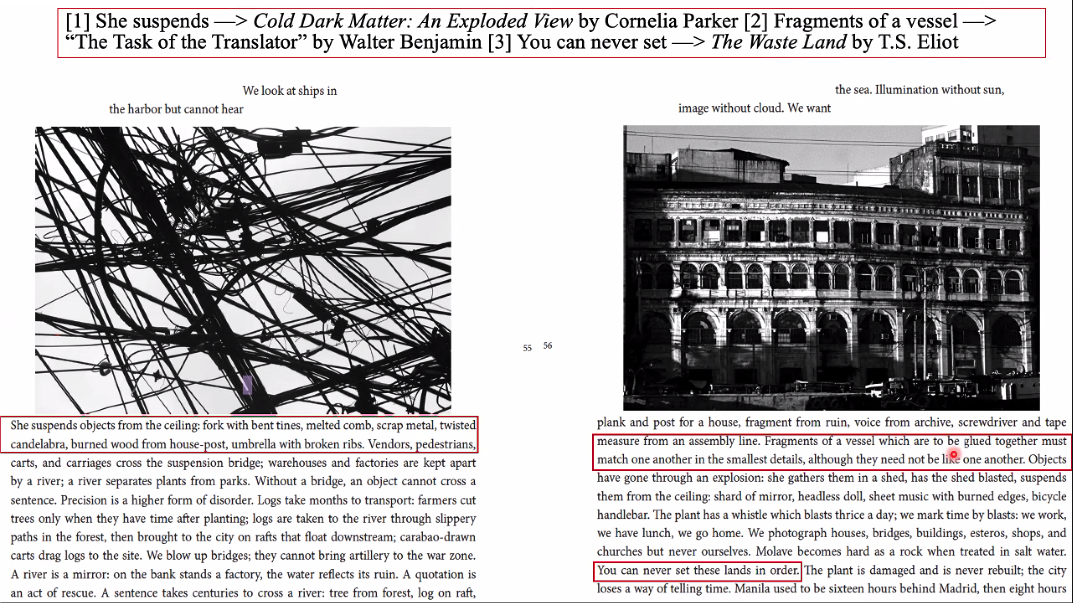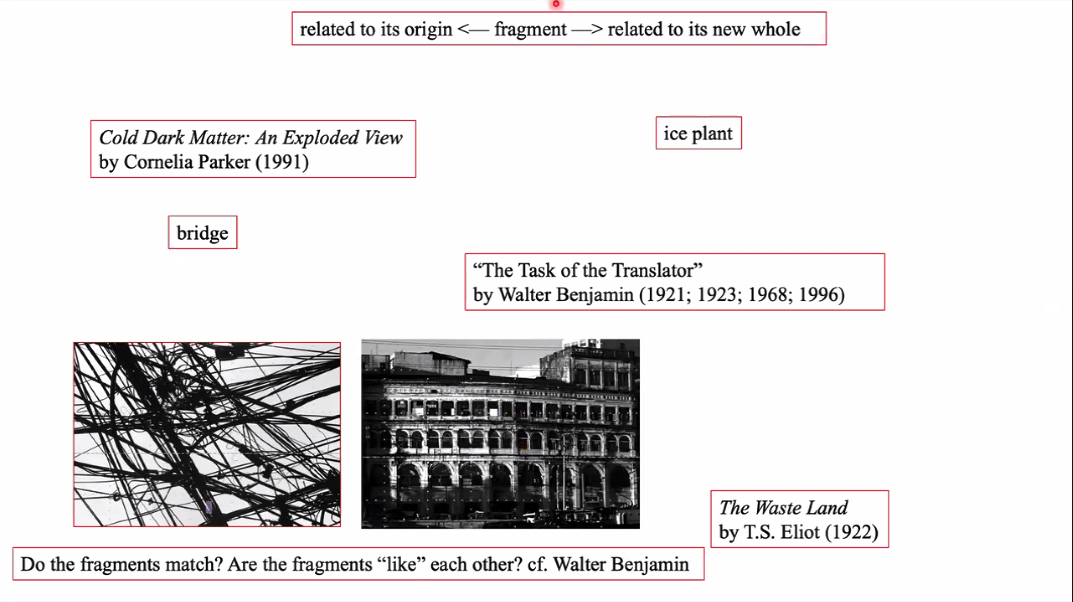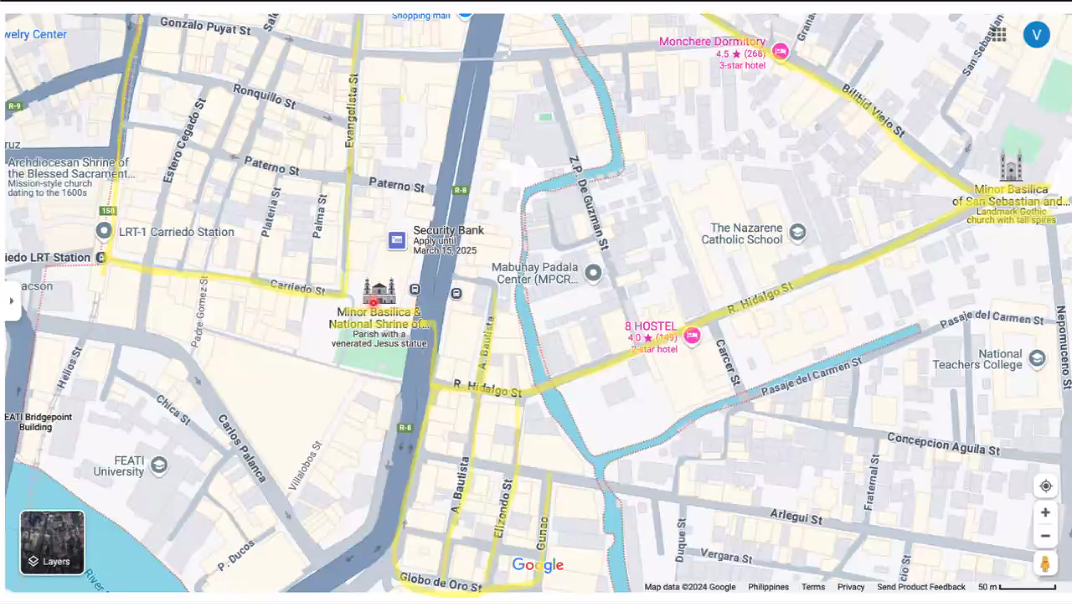Outline
- Figures of Manila: Manila as an archipelagic and a patchwork city
- Aesthetic strategies in Now is a new no: image-text, citation, and collage
- Walking as a method of creative production
- Poetry reading
- Open forum
Figures of Manila: Manila as an archipelagic and a patchwork city
Now is a new no uses a predominantly social science perspective.
The Origins of Metropolitan Manila by Manuel Caoili
Precolonial Manila
- subsistence economy
- trade with the Arab world, China, and parts of Southeast Asia
Manila during the Spanish colonial period
- galleon trade (1565–1813)
- Manila opened up to world trade (1814)
- Manila became a cosmopolitan city
- heightened class divisions (European-born Spaniards, Creoles, Spanish mestizos, Chinese mestizos, Chinese, foreigners, native principalia, lower classes)
Manila during the American period
- Burnham Plan and modernization (1905)
- but just the same unequal relations between Filipinos and Americans
- Filipino political and economic elite also benefited from American colonialism
Post-World War II Manila; Manila during the Marcos dictatorship
- increasing population density
- poor public services, incl. health, sanitation, transportation, etc.
- Metropolitan Manila Commission (1975) → Metro Manila Development Authority (1995)
Manila as archipelagic city
Island studies, Vince is slowly getting into it. Cities can be described as islandic.
Manila, City of Islands by Edwin Wise
“The ideal modernist city is centered on cultural, civic, or commercial points; it is dominated by secondary relations (gesellschaft); it is an arena of national spectacles; it has sites of exposure that allow the mingling of diverse populations; it is open to all classes, is public; and it is pedestrian with only inclinations toward automobile and carriage. The archipelagic city is multicentered, in that no one point contains a monopoly of cultural / civic / commercial activity; it is dominated by premodern and modern forms of urbanism—we see the acknowledged continuation of kin and community (gemeinschaft) relations alongside those of gesellschaft; it lacks unifying spectacles; it lacks exposure and lends itself to segregated spaces; and it contains various forms of transportation”
“Metropolitan Dreams” by Neferti X. M. Tadiar
“[F]lyovers perform the function of corridors leading to and from the exclusive, walled-in neighborhoods where the upper strata are ensconced. One might view this metropolitan form [Manila with flyovers] as a network house, a decentralized spatial system resembling an archipelago whose islands are interconnected by bridges. I say islands because subdivisions where the paradigms of the Western house with its solid, monolithic structures, geometrically-defined and partitioned spaces as well as its attention to housing content have most completely applied, are surrounded by a sea of ‘unplanned development.’ In these areas inundated by poverty and its haphazard production of space there is no other way to go but up and that is what flyovers do” (Fantasy-Production 91)
Manila as patchwork city
The Patchwork City: Class, Space, and Politics in Metro Manila by Marco Z. Garrido
“Urban fragmentation in Manila takes the form of interspersion. By interspersion, I mean the proximity of slums and enclaves as a general pattern. My argument, in a nutshell, is that interspersion worsens class relations by facilitating categorically unequal interaction in the form of boundary imposition” (51; emphasis in original)
Manila as a site of contradictions and struggles
“Encircle the Cities by the Countryside: The City in Philippine Writing” by E. San Juan, Jr.
“Manila, in these writers’ conceptions [Ave Perez Jacob, Lualhati Bautista, Levy Balgos de la Cruz, Rogelio Ordoñez, among others], displayed itself as the microcosm of the class-divided social totality in which personal compulsions coalesced into collective responses, but in the same breath these committed writers located within it those recalcitrant and disruptive forces that challenged the hegemony of the dominant elite who owned the material structures of the city” (164),
Aesthetic strategies in Now is a new no
Image-text
Contentious relations between pictures and text. Source of photos: Ateneo archives
Word and picture as rivals
The Midnight by Susan Howe
There was a time when bookbinders placed a tissue interleaf between frontispiece and title page in order to prevent illustration and text from rubbing together. Although a sign is understood to be consubstantial with the thing or being it represents, word and picture are essentially rivals. The transitional space between image and scripture is often a zone of contention. Here we must separate. Even printers and binders drift apart. Tissue paper for wrapping or folding can also be used for tracing. Mist-like transience. Listen, quick rustling. If a piece of sentence left unfinished can act as witness to a question proposed by a suspected ending, the other side is what will happen. Stage snow. Pantomime.
“Give me a sheet
Picture Theory by WJT Mitchell
One can and must, however, avoid the trap of comparison. The most important lesson one learns from composite works like Blake’s (or from mixed vernacular arts like comic strips, illustrated newspapers, and illuminated manuscripts) is that comparison itself is not a necessary procedure in the study of image-text relations.
The necessary subject matter is, rather, the whole ensemble of relations between media, and relations can be many other things besides similarity, resemblance, and analogy. Difference is just as important as similarity, antagonism as crucial as collaboration, dissonance and division of labor as interesting as harmony and blending of function. Even the concept of “relations” between media must be kept open to question: is radical incommensurability (cp. Foucault on Magritte’s pipe) a relation or a non relation? Is radical synthesis or identity of word and image (the utopian calligram) a relation or a nonrelation? The key thing, in my view, is not to foreclose the inquiry into the image/text problem with presuppositions that it is one kind of thing, appearing in a certain fixed repertoire of situations, and admitting of uniform descriptions or interpretive protocols” (89-90; emphasis in original).
pluralize image text relations
Vince doesn’t know the reactions on his work.
Citation
“The Politics of Citation” by Annabel L. Kim
“[C]itation is at the heart of the academic enterprise as what enables us to interface with others and take our place in a delicate and complicated ecology of knowledge production. It is intimately bound up with the treatment of ideas as property, with the dynamic of exchange turning that property into capital, into a vector for intellectual value” (5).
“What would it look like to cite not out of a sense of obligation where citing our sources performatively and/or aspirationally enunciates the shibboleths that admit us into the communities we wish to be part of, but to cite without regard for the institutional affiliation, clout, or discipline of the source in question? What would it look like to turn citation into a capacious relational site rather than the site of identitarian consolidation? Citation, in other words, [is] the map of a process, not the map of a territory” (7-8).
Strategy of citation.
- quoting and remixing quotations
- it is a powerful tool and strategy
- citation is processual not gatekeeping knowledge or being territorial

He was starting to write Now is a new no around 2015.
Collage
Cold Dark Matter: An Exploded View by Cornelia Parker (a work of art that inspired Vince)
Juxtapose materials together and see if they converse.
Group Mu, qtd. in “The Invention of Collage” by Marjorie Perloff
“Each cited element breaks the continuity or the linearity of the discourse and leads necessarily to a double reading: that of the fragment perceived in relation to its text of origin; that of the same fragment as incorporated into a new whole, a different totality. The trick of collage consists also of never entirely suppressing the alterity of these elements reunited in a temporary composition” (The Futurist Moment: Avant-Garde, Avant Guerre, and the Language of Rupture 47).
Collage
- once you gathered materials from citation, quotation, photographing, describing things while walking.
- Putting together gathered materials.
- relating the material to the origin + relating it to its new whole
How are we connecting these fragments?

Walking as a method of creative production
Gain immediacy, sensual knowledge. You feel both alienated and liberated.

The Walker: On Finding and Losing Yourself in the Modern City by Matthew Beaumont
“[T]hose most attuned to the contradictions of metropolitan modernity, those who live them at the level of the pavement, are best placed to grasp not only the city’s alienating but its liberating possibilities. This is what it means to be a modernist of the street” (19).
“Walking in the City” by Michel de Certeau
“The act of walking is to the urban system what the speech act is to language or to the statements uttered. At its most elementary level, it has a triple ‘enunciative’ function: it is a process of appropriation of the topographical system on the part of the pedestrian (just as the speaker appropriates and takes on the language); it is a spatial acting-out of the place (just as the speech act is an acoustic acting-out of language); and it implies relations among differentiated positions.” (The Practice of Everyday Life 97-98; emphasis in original)
Walking in relation to language
Poetry reading
Itinerary
- born out of a visit to Manila Hotel in 2012
Static
- what would radio static say had it been given a voice
Open forum
- Poetry is thought of as more spontaneous. But you did more research and theory.
In poetry there are a lot of expectations to be brief and expressive. Vince prefers poems that have longer forms. Vince aims to pluralize the definition of poetry.
-
Time and space
-
Collage: How did the collage making happen? Was it physical? As in cutting citations and moving them around in the table and pasting them on paper as in a physical collage? Or did you do this digitally or wrote this spontaneously on the page?
At the beginning just intuition. Editing: moved some quotations
- Black and white
Retrospection, vintage feel Influenced by Lav Diaz
- Hazardous areas; walking on areas wiped of history
There are was to historicity of a place even if it is wiped of tangible proofs.
- I’m curious if you could speak more about the role of the reader in your poetry. Your poetry is ensconced in this idea of walking as a means for creative production and it makes me wonder about how readers are likewise engaged in walking this textual locus and re-making the poem - amidst the images, the citations, and the juxtaposition of different styles of writing (lyric, prose-poem)?
You don’t have to read linearly. You can only look at the photos. Read Static separately or as one.
- Hi sir! May I ask how do you balance writing/make time for writing given your other roles as teacher and editor among others? Thank you!
Poetry comes secondary to Vince.
- Hello! I am new to your work, thank you for sharing. May I ask if there is something significant that you’ve learned about yourself in the experience of coming up with these creations? (Perhaps also in relation to poetry, photography and book-making?)
You need to be infinitely curious. He has walked many times and each time he learns something new. Curious about materials and process of composition.
In Manila, land is the embodiment of social and economic conflict.
- I am interested in the transition from prose poetry to lyrical poetry in your new book. How did you make artistic judgements on that transition? That seems to be the most abrupt change to me. Why the decision of lyrical-picture-prose poetry too? Not other combinations?
Personal reading: He read poets who wrote poet prose (Conchitina Cruz, Susan Howe)
References
Serrano, Vincenz. A Walkthrough of Now Is a New No. The Art of Craft Series.